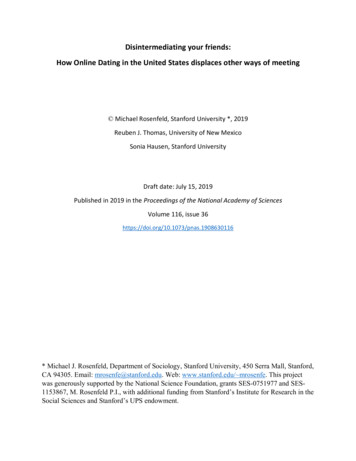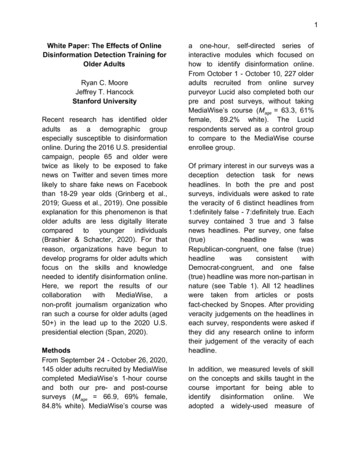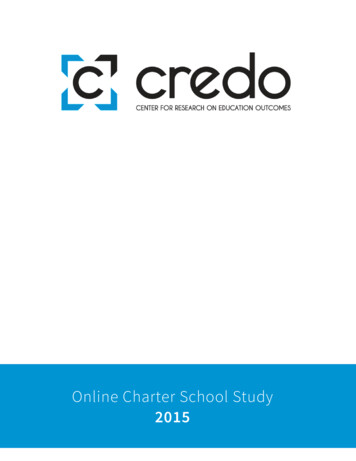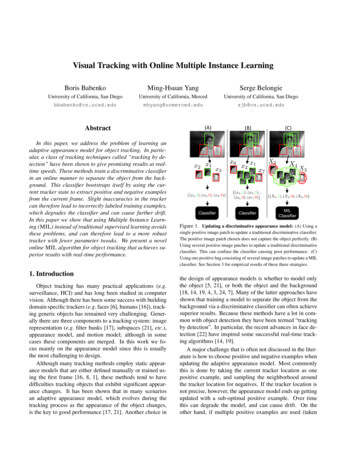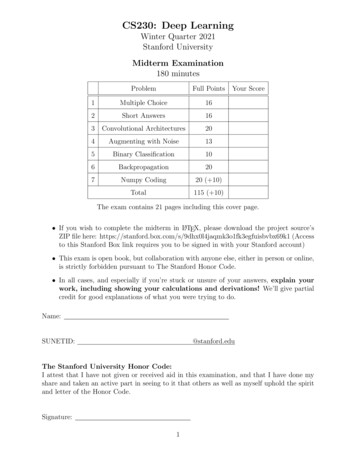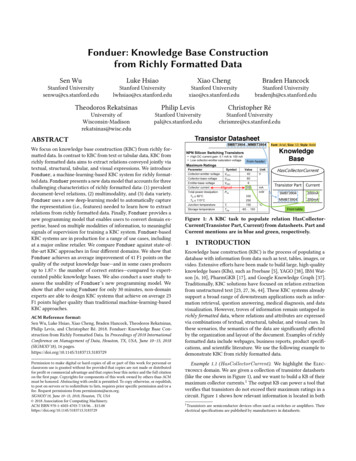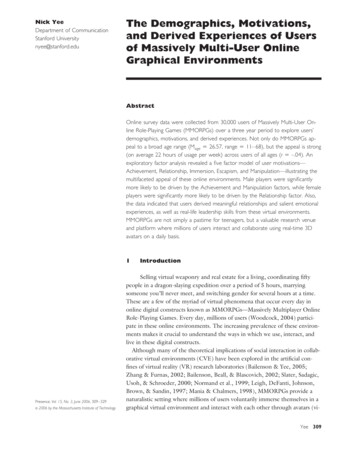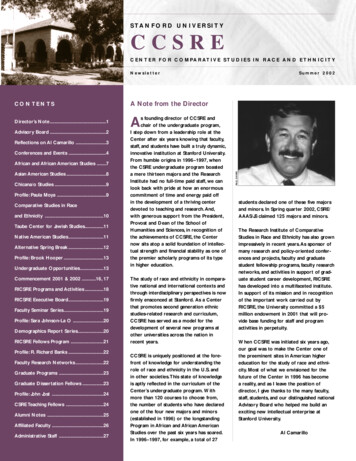
Transcription
CCSRES TA N F O R D U N I V E R S I T YCCSRE3C E N T E R F O R C O M PA R AT I V E S T U D I E S I N R A C E A N D E T H N I C I T YCONTENTSA Note from the DirectorDirector’s Note.1AAdvisory Board .2Reflections on Al Camarillo .3Conferences and Events .4African and African American Studies .7Asian American Studies .8Chicana/o Studies .9Profile: Paula Moya .9Comparative Studies in Raceand Ethnicity .10Taube Center for Jewish Studies.11Native American Studies.11Alternative Spring Break .12Profile: Brook Hooper .13Undergraduate Opportunities.13Commencement 2001 & 2002 .16, 17RICSRE Programs and Activities .18RICSRE Executive Board.19Faculty Seminar Series.19Profile: Sara Johnson-La O .20Demographics Report Series.20RICSRE Fellows Program .21Profile: R. Richard Banks .22Faculty Research Networks .22Graduate Programs .23Graduate Dissertation Fellows .23Profile: John Jost .24CSRE Teaching Fellows .24Alumni Notes .25Affiliated Faculty .26Administrative Staff .27s founding director of CCSRE andchair of the undergraduate program,I step down from a leadership role at theCenter after six years knowing that faculty,staff, and students have built a truly dynamic,innovative institution at Stanford University.From humble origins in 1996–1997, whenthe CSRE undergraduate program boasteda mere thirteen majors and the ResearchInstitute had no full-time paid staff, we canlook back with pride at how an enormouscommitment of time and energy paid offin the development of a thriving centerdevoted to teaching and research. And,with generous support from the President,Provost and Dean of the School ofHumanities and Sciences, in recognition ofthe achievements of CCSRE, the Centernow sits atop a solid foundation of intellectual strength and financial stability as one ofthe premier scholarly programs of its typein higher education.The study of race and ethnicity in comparative national and international contexts andthrough interdisciplinary perspectives is nowfirmly ensconced at Stanford. As a Centerthat promotes second generation ethnicstudies-related research and curriculum,CCSRE has served as a model for thedevelopment of several new programs atother universities across the nation inrecent years.CCSRE is uniquely positioned at the forefront of knowledge for understanding therole of race and ethnicity in the U.S. andin other societies.This state of knowledgeis aptly reflected in the curriculum of theCenter’s undergraduate program. Withmore than 120 courses to choose from,the number of students who have declaredone of the four new majors and minors(established in 1996) or the longstandingProgram in African and African AmericanStudies over the past six years has soared.In 1996–1997, for example, a total of 27Summer 2002PAUL DAVIESNewsletterstudents declared one of these five majorsand minors. In Spring quarter 2002, CSRE/AAAS/JS claimed 125 majors and minors.The Research Institute of ComparativeStudies in Race and Ethnicity has also grownimpressively in recent years. As sponsor ofmany research and policy-oriented conferences and projects, faculty and graduatestudent fellowship programs, faculty researchnetworks, and activities in support of graduate student career development, RICSREhas developed into a multifaceted institute.In support of its mission and in recognitionof the important work carried out byRICSRE, the University committed a 5million endowment in 2001 that will provide base funding for staff and programactivities in perpetuity.When CCSRE was initiated six years ago,our goal was to make the Center one ofthe preeminent sites in American highereducation for the study of race and ethnicity. Most of what we envisioned for thefuture of the Center in 1996 has becomea reality, and as I leave the position ofdirector, I give thanks to the many faculty,staff, students, and our distinguished nationalAdvisory Board who helped me build anexciting new intellectual enterprise atStanford University.Al Camarillo
CCSREPAUL DAVIES2Loren Kieve, Al Camarillo, and Maggie Andersen at the Advisory Board Dinner held on May 31.CCSRE Advisory BoardRichard W. Lyman, ChairPresident Emeritus, Stanford UniversityStanford, CAMargaret L. AndersenProfessor of Sociology, University ofDelawareNewark, DEVictor Arias, Jr.Consultant, Spencer StuartDallas,TXRaymond F. BacchettiScholar in Residence,The CarnegieFoundation for the Advancement of TeachingMenlo Park, CABarbara D. FinbergVice President, MEM AssociatesNew York, NYWill KymlickaProfessor of Philosophy, Queen’s UniversityOttawa, OntarioEvelyn Nakano GlennProfessor of Ethnic Studies and Women’sStudies, University of CaliforniaBerkeley, CAEugene Y. Lowe, Jr.Assistant to the President, NorthwesternUniversityEvanston, ILRobert C. GreggAssociate Dean of the School of Humanitiesand Sciences, Stanford UniversityStanford, CARaymund A. ParedesDirector, Creativity and Culture Program,The Rockefeller FoundationNew York, NYLoren KievePartner, Quinn Emanuel Urquhart Oliver &HedgesSan Francisco, CAEva Jefferson PatersonDirector, Lawyers’ Committee for CivilRightsSan Francisco, CALawrence D. BoboProfessor of Sociology, Harvard UniversityCambridge, MAAndy M. CamachoPresident, Andy M. Camacho Inc.Los Angeles, CANancy E. CantorChancellor, University of Illinois at UrbanaChampaignChampaign, ILRoger A. Clay, Jr.Senior Fellow, Institute on Race and Poverty,University of Minnesota Law SchoolMinneapolis, MNMariachi Cardenal de Stanford performing at a dinner honoring Al Camarillo.
CCSRE3Reflections on Al Camarillo’sContributions to CCSREby Paula Moyaesides being a key figure in the development of CCSRE, Al Camarillo hasbeen an important mentor to the manyundergraduate and graduate students anduntenured faculty affiliated with the program. In his capacity as chair of the CSREmajor, Al helped countless undergraduatestudents clarify their academic focus, develop their course schedules, and formulateinteresting and appropriate topics for theirundergraduate honors theses. In his capacity as director of CCSRE, Al secured fundingfor and oversaw the development of anumber of programs designed to facilitatethe research agendas of both graduate students and junior faculty working on issuesof race and ethnicity. Under his watch,CCSRE instituted several dissertation andteaching fellowships that provide neededfunding for students working across avariety of disciplines on issues of race andethnicity. Importantly, the fellowships havebeen instrumental in helping to create acommunity of scholars, because as a condition of their funding, teaching and dissertation fellows participate in the RICSREFaculty Seminar Series.BIt is as a mentor that Al Camarillo has hadthe most profound effect on me. One ofthe most important initiatives foruntenured faculty that Al put in place asdirector of CCSRE was the Junior FacultyProfession Development Project funded bythe Irvine Foundation.This program wasdesigned to “buy out” one course taughtby one or two junior faculty members peryear so that they could devote the extratime to working on their scholarship. In myown case, the extra time was so valuable,and the timing of the leave was so opportune, that I was able to complete the lastchapter of my first single-author book,Learning From Experience, during the quarter I took the leave. Finishing that bookwas, of course, instrumental to my successful bid for tenure.Even as he was building CCSRE, Alremained a committed scholar and teacher.Certainly, one of my most valuable teachingexperiences came during my second yearat Stanford when I team-taught with Althe “Introduction to Chicano History andCulture” course.Team-teaching with Al wasa tremendous learning experience for me,because he is a brilliant lecturer and masterteacher. Moreover, it is an experience thathas been instrumental to my success hereat Stanford. Among other things, I learnedthrough Al’s excellent example how towork effectively with TA’s and how to manage a large lecture class.I salute Al’s vision, his leadership qualities,and his willingness to mentor activelythose scholars who are coming behind him.He is an important scholar, a uniquely effective leader, and a wonderful human being. Ifeel deeply fortunate to have him as mycolleague. by George Fredricksonl Camarillo is the founding father ofthe Center for Comparative Studiesin Race and Ethnicity at Stanford.Thedemands of the students in the early 1990sfor the establishment of additional ethnicstudies majors could have resulted in aproliferation of small programs, whichmight have isolated or “ghettoized” students from diverse communities and wouldhave offered them only limited curricularchoices. In cooperation with H&S DeanJohn Shoven and other interested faculty(including myself), Al worked for theestablishment of a uniquely comparativeand interactive approach to the study ofgroup identities and situations.The factthat a substantial majority of the majorsin the program opt for the broadly comparative track, rather than the ethnicallyspecific ones, suggests that the time wasripe for such an innovation.AIn the half-dozen years of his directorshipof the Center, Al has seen its teaching component grow into one of the most popularof Stanford’s interdepartmental programs;both with students and with faculty. Heplanned and conducted a remarkable“gateway” course that created a forum forcolleagues from various departments toprovide students with an understanding ofhow the respective disciplines approach thesubject of race and ethnicity. More recently,he taught a gateway course on racial andethnic diversity in twentieth centuryAmerica, which had as its precursor theHistory course we taught together forseveral years on “Race and Ethnicity in theAmerican Experience.”The Center also provides the home for theResearch Institute.This was in part developed as an extension of a Faculty Seminaron Comparative Race and Ethnicity that Aland I helped to organize, initially with thesupport of then-Dean Ramón Saldívar andlater with funding from the Mellon foundation. One could trace Al’s involvementwith multicultural education at Stanfordback even further—to his founding of theStanford Center for Chicano Research in1980 and chairmanship of the UniversityCommittee on Minority Issues in the late1980s. For more than two decades, therefore, Al Camarillo has been the key figurein Stanford’s intellectual and curricularadaptation to a more diverse student bodyand a more diverse America.
4CCSREConferences and EventsThe CaliforniaAsian American ArtistBiographical DirectoryPublication Surveyn December 7 and 8, 2001,RICSRE sponsored an editorialcommittee meeting of the CaliforniaAsian American Artist BiographicalDirectory Publication Survey, whichwas initiated at San Francisco StateUniversity in 1996 and received funding from the National Endowmentfor the Humanities. An outgrowth ofthe SFSU exhibition With New Eyes:Toward an Asian American Art Historyin the Western United States and itscatalogue, the project aims to document the careers of roughly onethousand Californian artists withAsian ancestry working before 1965.The results of this research pointto the need for a rewriting ofregional art history and the culturalprofile of Asian American studies.Distinguished Asian Americanspecialists as well noted scholars inboth Asian and American art andindividuals with other expertise participated.This was the first meetingof the committee. In addition toscholars and students from SanFrancisco State University, facultyand students from StanfordUniversity and UCLA have shapedthe project during the last five years.Gordon Chang, Professor of Historyat Stanford, is a member of theEditorial Committee. RICSRE islooking forward to working withMark Johnson, the head of theproject, next year when he will bea Visiting Fellow at the ResearchInstitute. TEIKICHI HIKOYAMA CIRCA 1926PAUL DAVIESOGeorge Fredrickson, Ann Pettigrew,Tom Pettigrew, and Bob Zajonc“White Supremacy,Black Liberation”A Conversation with George Fredricksonmet Professor Fredrickson in his loftyoffice with big old windows, high ceilingsand tall bookshelves overlooking the courtyard the History building shares withCCSRE.We talked about him and theconference “White Supremacy, BlackLiberation” held in Fall 2001.The conference was a tribute to his academic workand his teaching. George Fredrickson isthe Edgar E. Robinson Professor of UnitedStates History. After an almost forty-yearcareer as a professor of history, he willpartially retire at the end of this academicyear. Eighteen of these years he spent atStanford. Another eighteen years he taughtand researched at Northwestern University,and before that he worked as an instructorof history at Harvard University.ILast year, three of Fredrickson’s formerdoctoral students—Ariela Gross (USC) andLeslie Harris (Emory University), bothPh.D.s from Stanford and Norrece Jones(Virginia Commonwealth University), aPh.D. from Northwestern—organized aconference to honor the legacy of theirformer advisor and dissertation director.The conference “White Supremacy, BlackLiberation” took place on November 2 and3, 2001 at Stanford. Many of Fredrickson’sformer students from Stanford and Northwestern flocked to campus and paidrespect to the scholar and teacher. Currentstudents of Fredrickson’s as well as colleagues from the History department andCCSRE joined the audience.The conference’s topic itself built on twobooks of Fredrickson’s: White Supremacy:A Comparative Study in American and SouthAfrican History (1981) and Black Liberation:A Comparative History of Black Ideologies inthe United States and South Africa (1995).While sifting through the mountain ofpaper from talks given at his conference,Fredrickson jokes that some of his studentshad outdone him with their careers. “Thisis the case,” he laughingly states, “of DaleKnoble who is the president of Denison
CCSRE35The conference drew Fredrickson’s disciples from many generations of his longteaching career. Most of them are professors themselves like Robert Harris Jr.,ViceProvost and Professor of Africana Studiesat Cornell University.The youngest wasStanford alumni Yonatan Eyal (B.A. inHistory, class of 2000), who is now a second year graduate student in History atHarvard University. While working withFredrickson as an undergraduate, Eyalpublished in the Illinois Historical Journaland won the Dean’s Award for AcademicAchievement in 1999.Two of Fredrickson’s very first doctoralstudents at Northwestern, Sterling Stuckey(UC Riverside) and Don H. Doyle (Vanderbilt University), paid their tribute as did—of course—Fredrickson’s former Stanfordstudents: James Campbell (Brown University)and Eric Rauchway (UC Davis). Campbellwas Fredrickson’s only Stanford studentwho worked on the comparison of theUnited States and South Africa; at theconference, he spoke about 20th centuryAfrican American travel accounts of Africa.Rauchway (UC Davis) was one the firstgraduate students whom Fredricksonadvised at Stanford.Tributes to Fredricksoncame also from Joseph Crespino andChristopher Lee, two current graduatestudents in Stanford’s History department.Among those involved with the conferenceitself were not only Fredrickson’s formerstudents but also fellow colleagues andscholars from Stanford and universitiesaround the country: Prof. Estelle Freedman(History) and Professor Clayborne Carson(History) each chaired a panel as didthe current President of the AmericanHistorical Association, Darlene Clark Hinefrom Michigan State University.continued on next pageL.A. CICERO/STANFORD UNIVERISTY NEWS SERVICEUniversity. I have never been a president,”Fredrickson chuckles, “I have been manythings. And I have been the Co-director ofRICSRE for some years, but the presidentof a university—no, I have not been that.”Guadalupe Valdés and Leanne Hinton at “Negotiating the New Racial Landscape in California” Conference.“Negotiating the New Racial Landscape in California”f Ward Connerly’s Racial Privacy Initiative is successful in banning the state ofCalifornia from collecting and using racial data, many of the discussions at CCSRE’s“Negotiating the New Racial Landscape in California” conference will no longer bepossible.The conference explored the changing demographics of the state and what itmeans for redistricting and voting patterns, language and bilingual education policies,equality in education, social justice, and racial representation in the media. Many of thepresentations examined how housing, education, employment, health care, and a person’s general well-being are correlated with racial identity; the loss of state-collecteddata would seriously hamper future study of these issues. Furthermore, demographersproject that within the next fifty years people identified currently as “minority” willcomprise half of the U.S. population. And the 2000 U.S. Census reports that Californiais the first state to reach this demographic composition. Understanding how increaseddiversity is negotiated in California may predict future patterns in the rest of the U.S.IProfessionals from many different backgrounds contributed to the presentations andpanel discussions at the conference. Angela Oh, an attorney and commissioner on theLos Angeles City Human Relations Commission participated in the dialogue on socialjustice and opportunity. Emerald Yeh, news anchor for KRON 4 T.V. contributed todiscussions on racial representations in the media. And Lawrence Bobo, Professor ofSociology at Harvard helped to shape an understanding of how the issues surroundingdiversity in California might look in the future.The conference, held on April 25–27, 2002 in the Frances C. Arrillaga Alumni Center,was free and open to the public thanks to the generous support from the James IrvineFoundation. Community members from across California attended the conferenceincluding students and professors from various universities and colleges, members ofthe law enforcement community, legal and political figures, individuals from schoolreform organizations, members of foundations and other community organizations, andstaff from various media outlets.For more information about the conference please visit our website athttp://ccsre.stanford.edu/news
6CCSREcoasts of the country.The “Future ofMinorities” project explores the role ofidentity in the shaping of a progressive andintellectually rigorous vision of minorityscholarship and education. Aimed atencouraging a debate among scholars ontheoretical and practical issues ranging fromethics and epistemology to political theoryand pedagogical practice, the project develops and defends a post-positivist realistalternative to the dominant views of identity and experience in the Humanities.RACISM by George M. FredricksonAccording to Fredrickson, the most exciting aspect of the conference for him wasseeing all these people again as theyhonored his work. Of course, Fredricksonappreciated that his former studentsthought he had been a sympathetic andaccessible advisor. “If this was true,”Fredrickson contemplates, “I would bevery delighted.” “The Future of MinorityStudies: Redefining IdentityPol
University of Minnesota Law School Minneapolis,MN Loren Kieve,Al Camarillo,and Maggie Andersen at the Advisory Board Dinner held on May 31. Barbara D.Finberg Vice President,MEM Associates New York,NY Evelyn Nakano Glenn Professor of Ethnic Studies and Women’s St
